
While our time in Bhutan began in early October, our first group of kayakers arrived on October 24th. All were familiar faces. Everyone had been on trips with us before. Although for a few, many years had passed. So we enjoyed quite a reunion, sharing pictures of new family members and stories of our last adventures together. Mary and I met folks at the airport along with our driver Hari, cultural guide Karma, Kali, an excellent kayaker and raft guide from Nepal (whom we met in Bhutan in 2006) and Tinley, a Bhutanese kayaker on the fast track to becoming a very strong paddler and guide.
The only airport in the country is located in Paro. Situated in the west, Paro is the second largest town in the country (with some 36,000 people including outlying areas). The flight in is both breathtaking and thrilling; breathtaking with views of the Himalaya and thrilling because the airport is nestled in a narrow valley that results in one of the most interesting approaches I have ever experienced in a commercial airliner.
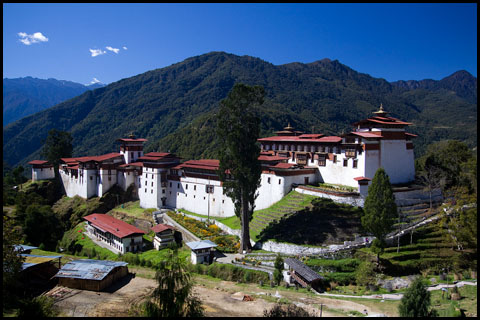
We spent that first day around Paro, visiting the downtown shops, the museum and the Paro Dzong. (Dzongs are fortresses that were built in the 16th century to protect the country from invasions from Tibet. All Dzongs now house both government offices and monasteries and are located in all of the major valleys throughout Bhutan.) We had the good fortune, known as sonam, to meet one of the four queens (sister-wives of the fourth king and mother of the present King) during our visit to the Paro Dzong. We were in the main courtyard when she and her entourage passed by. We were lined up in a row, shoulder to shoulder, and bowed together as she passed. She veered over to our group and very nicely said, “Oh, that is much too low… too much like in a movie”. She then proceeded to ask where we were from, shake each of our hands and asked that we pray for world peace. After the days activity, we checked into our hotel and then outfitted our brand new kayaks in preparation for the next day’s paddling.
The main road in Bhutan is the east-west highway. On this trip we would travel as far east as Jakar, located in the middle of the country in the district of Bumthang. Road travel in Bhutan, as in many third world countries, is best measured in time rather than distance. We planned to break up the drive by kayaking, hiking, and visiting dzongs and monasteries. Sonam (fortune that comes from past good behavior) came into play more than once during our stay, providing us with some wonderfully spontaneous opportunities, including getting to participate in unscheduled ceremonies and dances.

Bhutan is located along the eastern flanks of the Himalaya. It it bordered by India on three sides and Tibet to the north. From it’s high mountains a variety of rivers spill into parallel valleys. Our first day of boating began with a warm-up on the Paro Chu, a delightful run on the way to the capital city of Thimphu. The Paro Chu at that time of year is typically low volume with clear, cold water. Our stretch had a nice gentle start that slowly built, giving everyone a chance to loosen up after their long flights.

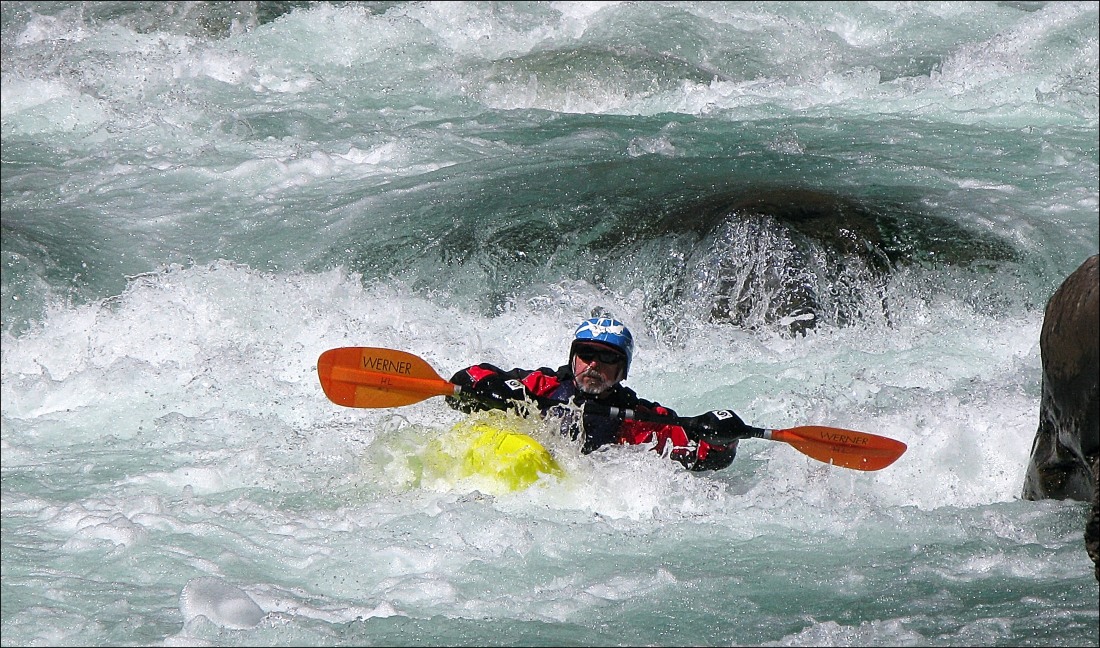
After boating we arrived in the capital of Thimphu to settle into our hotel and take the rest of the afternoon to walk about town, shop and see how things were coming together over at the national stadium for the upcoming coronation of the fifth king, Jigme Khesar Namgyel Wangchuck.
Traveling east the next day took us over the 10,299 ft. Dochu La (pass). It has an impressive 108 stupas and a grove of trees with one of the greatest concentrations of prayer flags we saw during our trip. Our day was crystal clear with spectacular views of the Himalayan range. We followed the road winding down to the Punakha valley, our next stop and where we would spend two nights camping in luxury along the banks of the Mo Chu (mother river).

This drive took us right past the Punakha Dzong. And we found out that this was the last day it would be open to the public before the upcoming coronation of the King -more sonam at work! The Dzong lies in a truly auspicious location at the confluence of the Mo and Po (mother and father) rivers and it plays an important role in the coronation of the king. For that reason it was being decorated to look it’s finest. Monks were seen scaling ladders to attach yards and yards of yellow fabric along the roof lines. The fabric rippled in the wind and looked like flames. Inside the Dzong, colorful cylinders of fabric were being hung in the courtyard and painted carvings were being touched up.

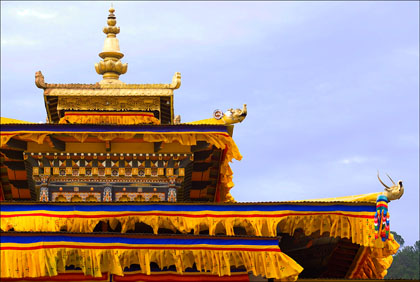
Over the next two days we paddled stretches of the Mo and Po Chu rivers, and did a bit of hiking to see the countryside or visit a ridge-top monastery. We then loaded on our bus and left the Punakha valley to climb our next pass, Pele La, to reach Jakar. Sonam was with us again as we learned that the date of the annual Jakar Dzong festival, normally held at a later in the month, had been moved up due to the coronation. We would be able to attend the festival and be treated to a colorful pageantry of customs, dress, and ceremonial dances. A planned morning paddle was moved later in the day so we could attend the festival. We did the same the following day and were able to see one of the huge fabric wall hangings (thondrol) that we had heard so much about but had never seen. Each Dzong has it’s own Thondrol -a massive artwork of applique and embroidery (made by the monks) that are several stories tall and in some cases, centuries old. The Thondrol is revealed once a year for a few hours only during the annual festival, then carefuly stored away for the next year.
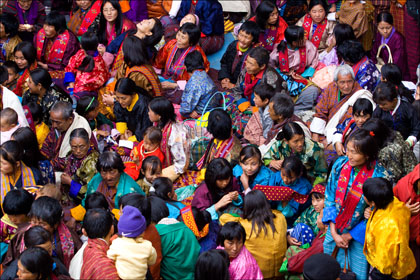
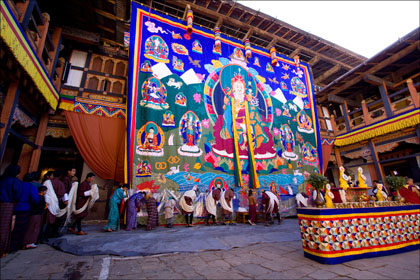

We had reached the point in our trip when it was time to start working our way west again to Paro. Backtracking over Pele La, we headed south at the old capital, the village of Trongsa. The Dzong here has a commanding view over the Mangde Chu river valley with some absolutely impressive stretches of white water below (impressive as in “there is no way I am paddling down there!”). Continuing south we arrived at the former winter palace of the first king where we had a special invitation to stay on the grounds and would be treated to a dance performance that night by the monks that now reside there.

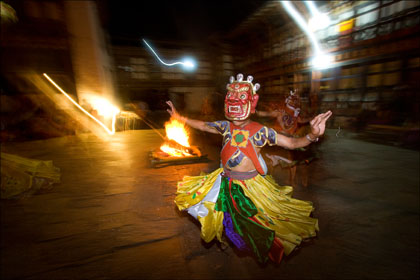
The following day we completed our drive to Paro. The last day in country the group made the spectacular 1800 ft vertical hike to the Tigers Nest monastery. Legend has it that Guru Rinpoche (who brought Buddhism to Bhutan) arrived here on the back of a flying tigress. An imprint of his body can be found in the rock cave where he meditated for many months. And once you visit Bhutan, you realize that here in this magical kingdom, that might have really happened.
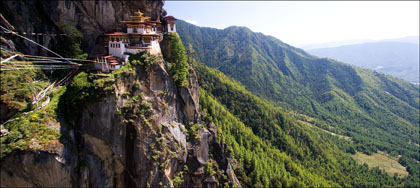
Photos and content ©DeRiemer Adventure Kayaking, all rights reserved.